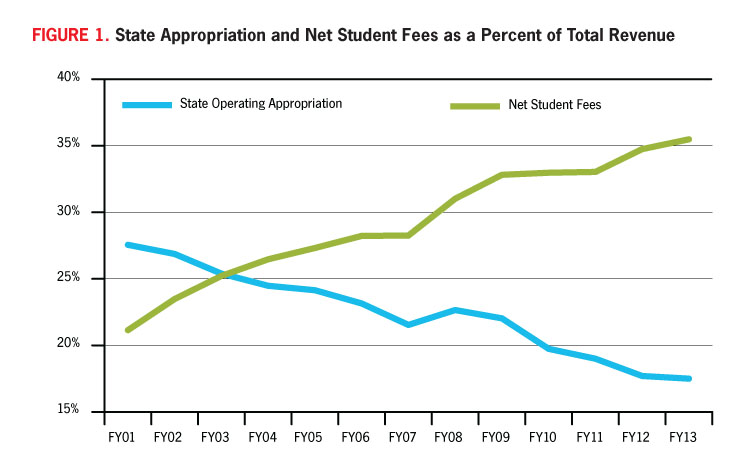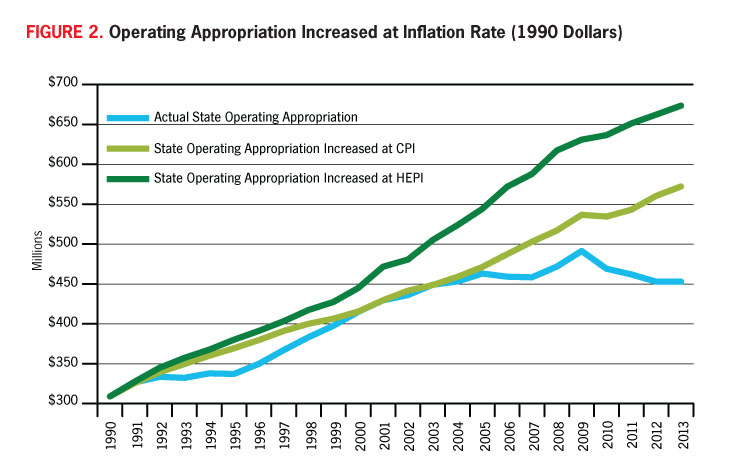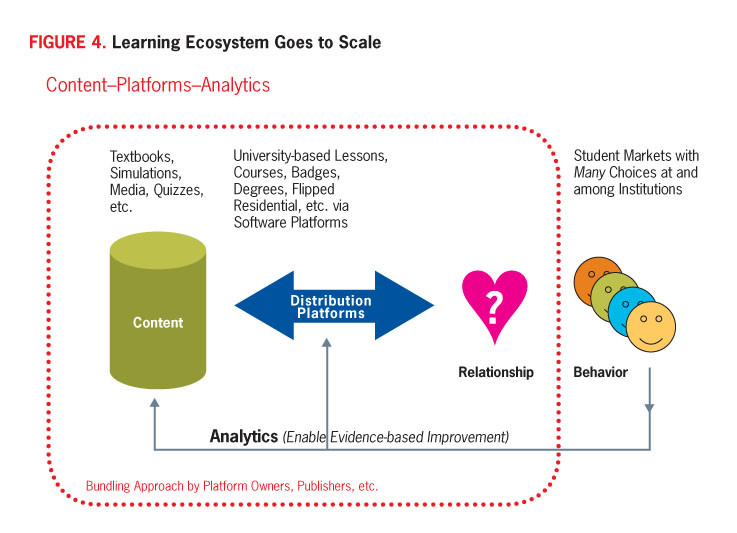Curves are full of unknowns, including their shape and whether they are gradually accelerating or decelerating. What are the curves that are reshaping higher education, and what are the smart bets along those curves that may bend them in our favor?

Brad Wheeler is Vice President for Information Technology and Chief Information Officer for Indiana University and a professor of information systems in IU's Kelley School of Business. He was a member of the EDUCAUSE Board of Directors for 2008–2012, serving as Treasurer and Vice Chair. Wheeler is the 2013 recipient of the EDUCAUSE Leadership Award, which honors exemplary leaders whose work has had significant positive impact on advancing the theory and practice of information technology in higher education.
I've always been fascinated by curves. Curves are an interesting way of looking at both changes and constants. Curves often obscure what lies around the bend, and they have the ability to surprise, delight, and terrify those who are trying to successfully navigate them.
Curves are not like predictable, linear lines. With linear lines, doing thing X at a certain time deterministically yields some outcome of Y. Y's outcome is predictable, so the decision becomes whether to do something now or to do it later. Unlike curves, linear lines are very understandable things. Curves are full of unknowns, including their shape and whether they are gradually accelerating or decelerating. MBA students learn to love curves that accelerate in the "march to the northeast corner," but curves rarely follow that path in a sustained way. In reality, they may accelerate or slow, and they may change directions (e.g., Gartner's oft-cited Hype Cycle).1 Thus, it is far less certain when, if ever, some action of X will yield some desired outcome of Y.
Given this uncertainty, when IT and campus leaders are confronted with an evolving curve of unknown shape, we have a tendency to want to wait: "We'll let the uncertainty drain out. Let's see what's around that curve before we come in." Farther along the curve there is often less uncertainty. But there is also less opportunity to change a curve. In many cases, the phenomenon represented by a curve is not something that just happens to us; our timely actions can actually co-create and change the shape of a curve.
CIO for Indiana University and EDUCAUSE Award Winner Brad Wheeler says that universities need to embrace intentional interdependence.
Some people are fairly shrewd at understanding curves and even bending curves to their interests. For example, in late October 2007, Goldman Sachs stock was worth $247 per share. In November 2008, it was worth $53 per share. That was not a pretty curve. But in September 2008, Warren Buffett agreed to invest $5 billion in Goldman Sachs, and in less than five years, he profited $2.1 billion on that investment alone. In that troubled economic period, he made more than $10 billion total for his firm, Berkshire Hathaway. As a Wall Street Journal reporter noted: "Few investors, if any, capitalized on the crisis as expertly."2 Buffett's philosophy for curves is often quoted from his 2004 chairman's letter: "Investors should remember that excitement and expenses are their enemies. And if they insist on trying to time their participation in equities, they should try to be fearful when others are greedy and greedy only when others are fearful."3
Our national culture does not celebrate cautious people; rather, we celebrate our heroes who think differently about curves, opportunity, risk, and innovation—whether Steve Jobs or Jeff Bezos. Not everyone knows that Lou Gerstner, the former CEO at RJR Nabisco and senior leader at American Express, saved IBM when the company was almost out of cash. He took on the internal IBM culture, killed the technically superior OS/2 operating system, and held the company together—performing one of the most remarkable turnarounds in corporate history. Likewise, again consider Warren Buffett. In the last decade, investors who diversified risk by owning index fund shares in the entire S&P 500 in 2000 and who sold those shares in 2010 lost 11 percent. Buffett's investors gained 78 percent during that time. Buffett and others not only adapted to the curves; they foresaw, understood, and very much shaped the curves.
This style of boldness is not how we tend to think in higher education. In many ways, we value the perceived security of taking on a curve slowly, individually, because we believe doing so minimizes our risk. Yet as we think about the frequently chronicled changes in higher education, we are driven to wonder: Could we capitalize on these changes as expertly as people who understand curves? What are the smart bets along those curves that may bend them in our favor, and what are the curves that are reshaping our industry?
Two Curves
Higher education faces a number of important curves, but I'll focus first on just two:
- The finance of higher education is increasingly moving from a public to a private good, leading to increasing cost and price pressures (particularly for state-supported institutions).
- The increasing digitization of education and research favors greater scale while it also enables potential new substitutes for colleges and universities.
Cost and Price Pressures
Higher education is under both tremendous cost pressures (e.g., energy, health care, compliance) and tremendous price pressures (i.e., the price students are willing to pay for credentials and educational experiences). The long-used tactic of raising tuition to offset increased costs and reduced state support is becoming unviable. Three graphs from Indiana University (IU) provide an illustration; most higher education institutions have variations of these curves.
The first graph (Figure 1) is "State Appropriation and Net Student Fees as a Percent of Total Revenue." The blue line is state support going to IU over time. IU has fared better in public support than many other institutions, but as the state puts less money in, students have to pay more to support the current educational model. Thus, higher education increasingly becomes a private purchase financed by students and their families, and this adds to price sensitivity among students as they choose institutions and course options.

The second graph (Figure 2) is a response to the sentiment that colleges and universities are inefficient bureaucracies. The blue line is the state operating appropriation to IU. If state funding since 1990 had held steady at the rate of inflation, specifically the consumer price index (CPI), the appropriation would be the light green line. If state funding had held steady at what is called the higher education price index (HEPI)—that is, the rate of inflation of the things that are most important to higher education (e.g., energy, health care)—the appropriation would be the dark green line. Institutions are doing more with less, but there is a revenue and cost gap that must be closed.

The final graph (Figure 3) is "State Operating Appropriation per Student FTE" (full-time equivalent). IU is operating at a level far below where it was even in 1997. This curve does not self-correct. The conclusion is that IU, along with other colleges and universities, must align its cost structure to what some have labeled "The New Normal" even as it must compete more vigorously for great faculty, students, and research funding.

At a meeting of research university CIOs in March 2013, some pondered: "What would it look like if we set a 2020 aspirational goal to reallocate 50 percent of the cost of administrative services (not just systems) into the core of the institutional mission—into scholarships, learning spaces, online learning, and research labs?" Now, 50 percent is not a simple nip and tuck around the edges. A more rational colleague thus counter-asked: "How 'bout we go with reducing the cost 20 percent by 2020?" The point is the same. To thrive in this decade and beyond, we must become much more rigorous about keeping our money in our core missions of education and research.
Digital Favors Scale
In industry after industry, we observe that digital goes to scale over time, since that is what the economics favor: per-unit cost goes down on the curve as volume goes up. These days, MOOCs (massive open online courses) and online learning, distance education, flipped classrooms, and blended classrooms are garnering a good deal of attention because they are most relevant to the first curve. As students become more concerned about the cost of their education, they become more price-sensitive to the full cost of attending a college or university, including the opportunity costs of foregone income and living at home, for example.
As education—whether residential, blended, or fully online—goes increasingly digital, three components will most likely favor scale beyond any of our individual institutions: content, distribution platforms, and analytics (see Figure 4).

- Content. The changes in textbooks, simulations, learning objects—that is, the costs of producing high-quality digital products—are not like the last technology change when faculty moved from overhead projectors to PowerPoint and clickers. That journey was mostly individual to each member of the faculty. This round of digital education is far more capital- and skills-intensive, creating interactive digital experiences with measurement of and adaptation to rates of learning. These are the early days of this curve, but we are already seeing exceptional (and unsustainable) institutional investments in many trials and pilots, investments by textbook publishers to move to adaptive digital experiences, and insurgent new entrants backed by tens of millions in venture capital dollars to "reinvent" higher education. For many institutional investments, the digital experiences often have very low reusability. The professor across the hall cannot find and use them—much less the professor in another department or on another campus—and the exceptional investments needed to maintain and enhance these experiences is beyond the scale of any single institution. Content is one area where digital economies will strongly favor scale, as has already been demonstrated in other transforming industries.
- Distribution Platforms. The Learning Management System (LMS) and its variants have long been viewed as the online learning distribution platform. But now, as content becomes platform, Coursera is growing like a juggernaut, edX is expanding, and publishers are producing adaptive learning systems. If we back up fifteen years and look at the initial heterogeneity of the LMS space, we see that the path to scale for software platforms played out with mergers and acquisitions and yielded a few dominant options with high switching costs among them. The platforms become increasingly important as education becomes more digital, since they provide distribution for educational experiences, courses, and degrees to students who are on or off campus. In business terms, these platforms are how our educational services reach markets of students both near and far away. And just as happened with Internet commerce more generally, students are becoming far more discerning in their educational purchases that these platforms enable.
- Analytics. Every click of online engagement, especially when correlated with other data from institutional student information systems, can provide the basis for greater insights via big data and learning science. Insights from analytics can provide empirical information to continuously improve both content and delivery platforms. We are at the earliest stages of understanding the potential for analytics in big and small data and the essential privacy and policy implications for our students, faculty, and institutions.
What will the curve for digital scale in content, distribution platforms, and analytics look like over time? Will this be another technology bust (e.g., CD-ROM) for "transforming" education, or will this time really be different?4 If it is different, what will be the strategic and timely investments needed from colleges and universities in the increasingly digital business of education? Will there be strategic threats to colleges and universities if others bundle content, distribution, and analytics services in ways that undermine the value of our educational offerings?
Revenue Models: Substitutes or Complements?
As we look at all the educational innovations and trends of recent years, the fundamental economic question is, "Are these substitutes for services that used to be bought at colleges and universities, or are these valuable complements to what we already do?" To the extent that a free MOOC becomes an automated digital textbook, a professor can assign parts of it to augment a rich class experience, and the college/university will get paid for the course credit. This may be an excellent resource for a class, with the MOOC complementing the educational experience of a tuition-bearing, residential, and/or distributed education course.
But what happens if students become so price-sensitive that in their first and second years they find digital substitutes—lower-cost substitutes—for their courses? In the United States, many states require transferability of those credits, so these students will arrive at our institutions not with 15 hours but with 60 or 75 credit hours. Colleges and universities are amazing structures of cross-subsidies. Junior- and senior-level courses generally cost more to deliver because they have fewer students and lower enrollments. Higher education institutions thus cross-subsidize from the higher-"margin" freshman and sophomore introductory courses. What will happen to the economics of these institutions without the first- and second-year revenues that have often cross-subsidized the more expensive instructional costs of the third and fourth years?
Online learning offers four revenue models to help cover costs. First is residential education. Just as reading paper textbooks has long provided a means for class preparation, viewing mini-lectures or other digital materials in advance can free face-to-face class time for more valuable learning engagements. For example, IU recently built a 96-seat Collaborative Learning Studio. The room has no focal point of attention for a lecturer; rather, it is structured for problem-based, team learning. The second revenue model is online courses and degrees, particularly for professionals. For example, IU's fully accredited online nursing program (a doctorate in nursing) and online MBA program are extremely good values. This leads to the third model: continuous education to alumni—through MOCs (Massive Online Courses), which can generate revenue. Finally, the fourth model is, of course, MOOCs, which create "revenue" in the form of social good or secondary value in sales of advertisements or data. The revenue and the costs of each model vary, from higher to lower:
- Residential education (flipped classrooms): $$$
- Online courses and degrees: $$
- Massive Online Courses (MOCs): $
- Massive Open Online Courses (MOOCs): Free
Each of these approaches has the potential to become a valuable complement to the economics of education or to evolve into a substitute for current offerings. At IU, we are deliberately focusing on the top three revenue models as complements to high-quality educational experiences.
Strategies for Coping with Curves
The strategies that higher education institutions use for coping with these curves tend to fall into three generic categories. Some institutions deploy the strategies in a reactive way while others use them proactively and hope to shape the curve itself.
Independence
The first strategy is independence. Campus independence as a strategy is in the DNA of the academy—at colleges and universities, we always had our own collections of books (books were rare) and our own scholars (scholars were rare). Students traveled to campuses, which were separated by physical distances. Colleges and universities were very independent entities.
Today, as aptly illustrated by "Island Envy" (Figure 5), campuses are on islands only a digital stone's throw apart, all imitating one another. We are leading and lagging each other by about a year or two, solving all the same problems with some strategy of independence, as if that were the best path for dealing with curves that are shaped by macro-economic forces.
Figure 5

The strategy of independence presumes abundant resources to make independent choices that fit the perceived needs of a single institution, without the complexities of coordinating with other institutions to create scale. Independence provides the greatest flexibility to accommodate local politics, and when used wisely and in rare circumstances, it may create a short-run period of valuable differentiation.
Dependence
The second strategy is dependence. In the 1980s and through today, higher education institutions have participated in the efficiencies of digital scale via the commercial marketplace of providers. The seed of this strategy comes from "The Core Competence of the Corporation," a 1990 Harvard Business Review article written by C. K. Prahalad and Gary Hamel.5 Essentially, the argument is: "You're Procter & Gamble. You make diapers. You sell soap. You don't want to run IT. You don't want to own delivery trucks. Outsource all that stuff." That mantra pervaded corporate America through the 1990s. Many of those leaders came onto higher education institutional boards and said: "Get out of all these support services. Just go buy from the marketplace." If the marketplace were vibrant and dynamic—and if there were many, many buyers; many, many sellers; and very low switching costs—that would be a great solution. But that is rarely how the markets for higher ed IT services work.
During this time, many administrative systems shifted from home-grown, independent systems to commercially vended systems. Scholarly journals and textbooks were rented from a consolidating set of publishers. Institutions connected to the ever-essential Internet and to each other via Regional Networks and Internet2. Campuses are dependent on these relationships.
Interdependence
The third strategy is interdependence—that is, intentionally relying on each other. Librarians, for example, have a long history of cooperation and sharing and have long ensured the preservation of knowledge and collections via modest interdependence and cooperative sharing to further the mission of scholarship.
If IU's good friends at The Ohio State University went away tomorrow, there would be few real consequences to IU. If, however, the University of Michigan went away, things at IU would break immediately. IU is interdependent with Michigan in jointly operating the HathiTrust and other services. We have an intentional interdependence.
To be clear, interdependence is not saying: "Oh, we play nice across the islands. We collaborate, but we maintain our absolute independence." We are saying: "I'm going to reduce my costs, and I'm going to drive and innovate and get more because we're in this to create scale and efficiency together." Interdependence is very different from independence and dependence.
Personal Insights on the Three Strategies
Each strategy has a time and place, and each may be a good fit for certain opportunities or challenges. For example, IU's IT team has received years of student survey responses indicating frustration with navigating IU's portal to the myriad university services from many IU departments. Our development team had been looking at what to do about the problem. They came to me in March 2013 and said: "We're going to fix this. We've got an idea. We just need you to say OK." I responded: "If you can do it by the fall of 2013, I approve." Off they went on an independent and rapid strategy. In October 2013, the team turned on "One." It replaced a decade of portal navigation with that clever thing called "Search." Type in a task—for example, "drop a class" or "buy John Stewart tickets" or "clock out"—and it brings up apps that go as directly as possible to achieving that outcome for a user. If a student wants to pay a parking ticket, the system will not guide the student to the parking web page; it guides the student to the means for paying a ticket. The goal is "search, click, done."
This idea was not collaborative beyond the institution. The team said: "Heads down, let's build this, let's go fast." Independence has a place: when we need to truly innovate and move fast, off we go.
Things become a little more interesting if we want to cope with a curve by involving others. Building big enterprise systems alone is really hard. We've learned that building them with the help of others is even harder—but far better for sustainability over time. Dependence and interdependence bring coordination costs and complexities as the price of shared economics.
Higher education as an industry has learned a lot about real collaboration for interdependence over the last decade or so. Often the seed is planted when we recognize a similar problem around the same time and aspire to a similar solution that needs resources beyond our individual means. We socialize the idea with others, and in time, we may begin a path toward dependence or interdependence together.
This works really well, until a conflict arises, and there are generally only two tools for timely conflict resolution. The first tool is authority. "You report to me; I have the budget. Therefore, it will be my ball, my way." Authority can end the endless debates. As we joke in academia, a committee vote of 31 to 1 is considered a tie and is sent on for further deliberation. Sometimes we need authority as a way to resolve something. But in many interdependent and collaborative activities, we do not have any means of authority. We have to resolve conflicts through the second tool: influence—presenting ideas, convincing each other, working on the shared pace and objectives. Either way, when we resolve conflicts via authority or via influence, we can achieve larger and more valuable things together—things that we could not have achieved on our own.
In the interdependence strategy, colleges and universities—and some commercial firms—have over a decade of insightful lessons about aspiration and conflict resolution for outcomes. The first, for many of us, was Sakai. Those who worked on Sakai learned some lessons from the uPortal project; in turn, Kuali members learned some lessons from what those working on Sakai did earlier. The HathiTrust, for digital libraries, was organized quite differently but took some of the principles from Kuali and Internet2. We are currently working on the Digital Preservation Network (DPN) and on Internet2's NET+ initiative. All of these projects—some for dependence and some for interdependence—differ, and each has assembled processes and models that best fit a particular interdependent community. We've learned much from these experiences, and any new interdependent efforts should draw on those insights and not relearn any of those lessons again—or, to put it more tersely: "Let's make different mistakes next time."
The Marketecture of Community
What are some of those insights for the campus strategies of dependence and interdependence as strategies to cope with the curves? James Hilton, dean of libraries at the University of Michigan, and I have asserted that there is a marketplace of ideas for intentionally interdependent communities and that communities require a strong architecture to resolve the inevitable conflicts. We call this the Marketecture of Community.6 If there is no architecture for dealing with conflicts—through authority and/or influence—then these communities tend to break and fall apart over time. The concept is illustrated by the Marketecture Matrix (see Figure 6), a two-by-two grid with an overlay of the strategies for dependence and independence.

A few examples may help illustrate the Marketecture Matrix. The horizontal axis is authority—whether we have lower authority or higher authority to resolve a conflict of price, features, or timing. IU has low influence to change our vended student information system. We can send the student information system software owner a note, but that's unlikely to yield much change. In contrast, IU has higher authority on our independent "One" project. IU is developing the project and bore the full cost of creating it. By virtue of owning it, the university has the means to steer it in a particular direction. IU also owns the Kuali software—as does every institution via the open-source license. IU has the unilateral authority to change the software if we deem that doing so is critical, and we can contribute those changes directly back to the community. IU has limited influence to persuade the community to incorporate our changes into the ongoing Kuali core software. The community itself, through its governing processes, has authority to resolve any conflicts.
The vertical axis is influence, higher and lower. Marketplace is the lower left quadrant, which is principally the box for the campus strategy of dependence—in a good way, not a bad way. For example, IU has a contract with a firm that takes care of federal W2 reporting. IU is dependent on the firm for federal compliance, and it does a good job. "Dependence" indicates a decision to be dependent on the firm, which is a good thing for the university. IU has very low influence with that firm and no ownership authority for the software or service. Since the service is neither expensive nor strategic, a strategy of dependence is a good fit.
When an institution signs a contract to use Oracle or Blackboard or Xlibris, it generally enters a no-ownership and low-influence relationship. If we contract with Workday or other off-premises companies—this seemingly new thing called the cloud—we have the same low influence, if not even less.7 In this quadrant and for on- or off-premises software, there is nothing new under the sun. We do not own the software, so we have low authority. Eventually, as one of countless customers who may get thrown into a merger-and-acquisition corporate distraction, we also usually have very modest influence from any single institution.
The Value of Greater Influence
We can enhance our influence (upper-left quadrant) if we come together collectively. The NET+ service from Internet2 is aggregating our demand and working with firms to influence and even proactively design product offerings that meet our needs. Given the very high influence via aggregation and product design, this is much more than a traditional buying club. Consider Internet2's pioneering NET+ deal with Box.com. Box brought a product to the marketplace, but it had its own log-in and authentication systems, and it charged for transport in and out of its data center. Internet2 said, "No, we already have credentials through our universities." Box made that change. Internet2 erased transport charges by connecting Box's data center directly to the Internet2 network. Through NET+, higher education institutions can collectively increase our influence from a single campus dependence on a provider to multi-institutional interdependence. We still have low authority via no ownership, but we are getting far greater influence for what we want in the now somewhat interdependent relationship together.
The Value of Greater Ownership
The right side of the matrix is higher authority via ownership. Cooperative Communities (lower-right quadrant) are illustrated by open-source software communities that offer some degree of dependence with high ownership rights. As James Hilton says, you and I can cooperate for a very long time, because the central premise of cooperation is, "You don't hurt me, and I won't hurt you." We are not hugely interdependent—you do X, and I do Y—but we are part of the same open-source community. We have severable property rights in the software, but participating means we often have modest degrees of influence as well. The influence is greater than zero, but it can be modest.
Collaborative Communities (upper-right quadrant) are illustrated by community source efforts, where we contract among institutions to develop or operate software and services together in the strategy of interdependence—very intentional interdependence. For example, the HathiTrust is a community-directed shared service that now has almost 12 million fully digitized books with over 70 libraries as contracted partners. Members of the HathiTrust pay fairly substantial fees every year, based on what they have in the digital repository and their proportional share of commonly available content. Likewise, if members of Kuali want to shape how the Kuali Financial or Student System works, they can buy a seat at the table that has the authority to steer collective investment in the software. In collaborative communities, institutions have to put more skin in the game to move to higher influence. But both the HathiTrust services and Kuali software remain free for use by anyone who is fine with low influence (essentially the strategy of dependence). The right-side quadrants of Cooperative Communities and Collaborative Communities have both proven to be effectual tools for favorably bending the cost curves of essential software systems and services.
Thus, the quadrants of Contracts, Clubs, Cooperative, and Collaborative illustrate the roles of authority and influence to resolve conflicts as they relate to the generic strategies of dependence and interdependence. These approaches are tools to help institutions find a path toward containing costs and participating in the favorable economies of scale that are imposed by greater digitization of education and research. At issue, then, for each of our institutions is a critical question: who is making strategic choices for independence, dependence, and interdependence as a means to address the two fundamental curves that are reshaping higher education? This brings us to a third and diverging curve.
Paths for Campus IT Leadership: A Third Curve
In their book The New CIO Leader, Marianne Broadbent and Ellen Kitzis assert that there are really only two paths for executive CIOs: they can leverage their expertise and move into a more strategic role, or they can run a utility and be relegated to the sidelines. The growing or waning influence of the campus IT leader over time is an oft-discussed topic in EDUCAUSE Review and at many CIO gatherings.8 Either path can be valid for different institutions at different chapters of time. However, as the academy's core missions of research and education become increasingly technologically dependent and interdependent, institutions need knowledgeable, experienced voices to advise and execute on strategic systems and institutional change investments for the economic curves ahead.
In my view, taking the utility path for information technology is ill-suited to the pace of economic, social, and technological change confronting colleges and universities in this decade. The move to off-premises cloud services amplifies rather than lessens that concern. Integration and switching costs for these services will go up as they further diminish the usefulness of the authority and influence tools that may be needed as we remake the academy. I see two core challenges for the CIO curve.
First, many CIO jobs are still structured for the perceived needs of the 1990s. The role of creating scale and efficiencies within an institution—a role that includes staff development, career mobility, and leveraging of infrastructure—is not included in the authority of the job. Many CIO job postings, search firm efforts, and the position descriptions themselves speak of lofty institutional aspirations but structure the job away from the core missions of education and research. Understandably, few senior executives know much about hiring and working with an IT-skilled executive leader to help achieve those institutional aspirations.
Second, and this is a bit of a delicate subject, we are not producing the level of talent for CIO leadership roles to keep pace with a wave of retirements and other transitions. We have to collectively find better and more systemic ways to develop talent that merits a seat at the executive table. I sometimes hear CIOs say that they want someone at their institution to move the reporting line of the CIO to a more executive role. In my observation over the years, that change most often occurs when a CIO can demonstrate that he or she has sage and valued advice and effectiveness to earn the seat.
I observe that the CIO curve is diverging as the CIO role at some institutions is gaining responsibilities while at other institutions it is losing even influence. We are now seeing all sorts of substitutes arise under titles such as Chief Digital Officer or Vice Provost for Online Education. These are timely titles, but they may be unnecessary over time if the CIO is achieving success in helping the institution reach its potential. We don't have ready solutions to the two problems caused by the curve of diminishing influence for the CIO position, but I do have one suggestion: I want to encourage some of my leadership-oriented faculty colleagues to consider whether the CIO job might be a timely career next step for them.
Conclusion
What to Read Next

The CIO-CBO Partnership

Libraries in the Time of MOOCs

Higher Education: New Models, New Rules
The Marketecture of Community
In higher education, we are facing a series of unprecedented curves that our trustees, our senior academic leaders, our senior administrative leaders, and our deans have never seen before. This article relates two challenging curves, three generic strategies for institutions, and four quadrants of influence/authority for shaping the curves. Cost pressures and the increasing digitization of research and education are necessitating a greater shift from campus strategies of independence to dependence and interdependence. The cost of rabid independence in common services will become too great for all but the wealthiest of institutions.
As this happens, who, then, are our higher ed leaders who will dare to think differently? Who will foresee and shape the solutions for dependence and interdependence to address the challenges of our era rather than respond to these forces as they reshape us? Will we look back and say: "They thought differently. They redefined education for small colleges. They cut the cost of administrative services in half and funded a remarkable blended learning program."
Digital favors scale, and its effects are accelerating in higher education. The habit of hoping and waiting for reduced risks around a curve is often illusory. Our actions via strategy co-shape the curves, which are often more malleable in their early rather than later stages. Unlike some critics, I have immense confidence in the capacity of those of us in the academy to continue to adapt, just as our institutions have done for millennia. There is tremendous opportunity in speeding up on curves. We can bend them in a direction that favors the extraordinary mission of higher education.
- See "Hype Cycles," Gartner website.
- Anupreeta Das, "Berkshire Crisis Haul Reaches $10 Billion" [http://online.wsj.com/news/articles/SB40001424052702304441404579119742104942198], Wall Street Journal, October 7, 2013.
- Warren E. Buffet, "To the Shareholders of Berkshire Hathaway Inc.," February 28, 2005, p. 4.
- Committee on Institutional Cooperation, Chief Information Officers, "Is This Time Different?" August 2012.
- C. K. Prahalad and Gary Hamel, "The Core Competence of the Corporation," Harvard Business Review, May 1990.
- Brad Wheeler and James L. Hilton, "The Marketecture of Community," EDUCAUSE Review, vol. 47, no. 6 (November/December 2012).
- Brad Wheeler and Shelton Waggener, "Above-Campus Services: Shaping the Promise of Cloud Computing for Higher Education," EDUCAUSE Review, vol. 44, no. 6 (November/December 2009).
- Michael A. McRobbie and Brad Wheeler, "Three Insights for Presidents and CIOs," EDUCAUSE Review, vol. 45, no. 3 (May/June 2010).
© 2014 Brad Wheeler. The text of this article is licensed under the Creative Commons Attribution 4.0 International License.
EDUCAUSE Review, vol. 49, no. 1 (January/February 2014)
